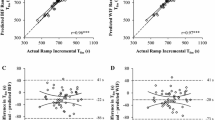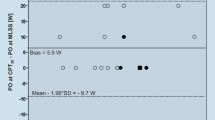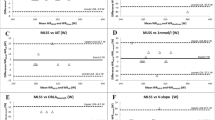Abstract
Purpose
The aims of this study were (1) to investigate if the respiratory compensation point (RCP) as derived from ramp incremental (RI) exercise could accurately predict the power output (PO) at the maximal lactate steady state (MLSS), and (2) to compare its accuracy with the second lactate threshold (LT2) obtained from step incremental (SI) exercise.
Methods
Nineteen participants performed a RI test (30 W·min−1) to determine RCP, a SI test (30 or 40 W·3 min−1) to determine LT2, and two or more constant work rate (CWR) tests to determine MLSS. For each participant, the \(\dot{\text{V}}\)O2/PO relationship for RI and CWR exercise was established. The ramp-identified PO at RCP was corrected by accounting for the gap between these relationships using the individually determined \(\dot{\text{V}}\) O2/PO regression above GET (RCPcorr-1) or using a fixed regression slope (RCPcorr-2). LT2 was determined using four methods: Dmax, modified Dmax (ModDmax), 4-mM threshold (LT4mM) and an expert-determined LT2 (LT2-expert).
Results
RCPcorr-1 (235 ± 69 W), RCPcorr-2 (228 ± 58 W) and LT2-expert (227 ± 61 W) were not different from MLSS (225 ± 60 W). Dmax (203 ± 53 W) underestimated MLSS, while RCP (280 ± 60 W), ModDmax (235 ± 67 W) and LT4mM (234 ± 68 W) overestimated MLSS. The \(\dot{\text{V}}\)O2 at RCP (3.13 ± 0.79L·min−1) and LT2-expert (2.99 ± 0.19L·min−1) did not differ from MLSS (3.05 ± 0.72 L·min−1).
Conclusion
This study demonstrated that RCP as derived from RI exercise and LT2 as derived from SI exercise can be equally accurate to determine the PO associated with MLSS. Although these results confirmed the suitability of RI and SI tests for this purpose, they also highlighted the importance of an appropriate threshold method selection and the eye of the expert.





Similar content being viewed by others
Abbreviations
- ANOVA:
-
Analysis of variance
- CWR:
-
Constant work rate
- GET:
-
Gas exchange threshold
- HR:
-
Heart rate
- ICC:
-
Intraclass correlation coefficient
- La- :
-
Lactate
- LT2 :
-
Second lactate threshold
- LoA:
-
Limits of agreement
- MLSS:
-
Maximal lactate steady state
- MMSS:
-
Maximal metabolic steady state
- MRT:
-
Mean response time
- PO:
-
Power output
- RI:
-
Ramp incremental
- RCP:
-
Respiratory compensation point
- SI:
-
Step incremental
- CI95% :
-
95% confidence interval
References
Beaver WL, Wasserman K, Whipp BJ (1986) A new method for detecting anaerobic threshold by gas exchange. J Appl Physiol 60:2020–2027. https://doi.org/10.1152/jappl.1986.60.6.2020
Beneke R (2003) Methodological aspects of maximal lactate steady state—implications for performance testing. Eur J Appl Physiol 89:95–99. https://doi.org/10.1007/s00421-002-0783-1
Binder RK, Wonisch M, Corra U et al (2008) Methodological approach to the first and second lactate threshold in incremental cardiopulmonary exercise testing. Eur Jf Cardiovasc Preven Rehabil 15:726–734. https://doi.org/10.1097/HJR.0b013e328304fed4
Bishop D, Jenkins DG, Mackinnon LT (1998) The relationship between plasma lactate parameters, Wpeak and 1-h cycling performance in women. Med Sci Sports Exerc 30:1270–1275. https://doi.org/10.1097/00005768-199808000-00014
Boone J, Bourgois J (2012) The oxygen uptake response to incremental ramp exercise: methodogical and physiological issues. Sports Med 42:511–526. https://doi.org/10.2165/11599690-000000000-00000
Caen K, Vermeire K, Bourgois JG, Boone J (2018) Exercise thresholds on trial: are they really equivalent? Med Sci Sports Exerc 50:1277–1284. https://doi.org/10.1249/MSS.0000000000001547
Caen K, Boone J, Bourgois JG et al (2020) Translating ramp V˙O2 into constant power output: a novel strategy that minds the gap. Med Sci Sports Exerc. https://doi.org/10.1249/MSS.0000000000002328
Cheng B, Kuipers H, Snyder A et al (1992) A New approach for the determination of ventilatory and lactate thresholds. Int J Sports Med 13:518–522. https://doi.org/10.1055/s-2007-1021309
Heck H, Mader A, Hess G et al (1985) Justification of the 4-mmol/l lactate threshold. Int J Sports Med 06:117–130. https://doi.org/10.1055/s-2008-1025824
Iannetta D, Qahtani A, Mattioni Maturana F, Murias JM (2017) The near-infrared spectroscopy-derived deoxygenated haemoglobin breaking-point is a repeatable measure that demarcates exercise intensity domains. J Sci Med Sport 20:873–877. https://doi.org/10.1016/j.jsams.2017.01.237
Iannetta D, Fontana FY, Maturana FM et al (2018) An equation to predict the maximal lactate steady state from ramp-incremental exercise test data in cycling. J Sci Med Sport 21:1274–1280. https://doi.org/10.1016/j.jsams.2018.05.004
Iannetta D, de Almeida AR, Keir DA, Murias JM (2019) Establishing the V̇ o2 versus constant-work-rate relationship from ramp-incremental exercise: simple strategies for an unsolved problem. J Appl Physiol 127:1519–1527. https://doi.org/10.1152/japplphysiol.00508.2019
Iannetta D, Inglis EC, Pogliaghi S et al (2020) A “Step-Ramp-Step” Protocol to Identify the Maximal Metabolic Steady State. Med Sci Sports Exer. https://doi.org/10.1249/MSS.0000000000002343
Inglis EC, Iannetta D, Keir DA, Murias JM (2020) Training-induced changes in the respiratory compensation point, deoxyhemoglobin break point, and maximal lactate steady state: evidence of equivalence. Int J Sports Physiol Perform 15:119–125. https://doi.org/10.1123/ijspp.2019-0046
Jamnick NA, Botella J, Pyne DB, Bishop DJ (2018) Manipulating graded exercise test variables affects the validity of the lactate threshold and V˙O2peak. PLoS ONE 13:e0199794. https://doi.org/10.1371/journal.pone.0199794
Keir DA, Fontana FY, Robertson TC et al (2015) Exercise intensity thresholds: identifying the boundaries of sustainable performance. Med Sci Sports Exerc 47:1932–1940. https://doi.org/10.1249/MSS.0000000000000613
Keir DA, Paterson DH, Kowalchuk JM, Murias JM (2018) Using ramp-incremental V̇ O 2 responses for constant-intensity exercise selection. Appl Physiol Nutr Metab 43:882–892. https://doi.org/10.1139/apnm-2017-0826
Kindermann W, Simon G, Keul J (1979) The significance of the aerobic-anaerobic transition for the determination of work load intensities during endurance training. Europ J Appl Physiol 42:25–34. https://doi.org/10.1007/BF00421101
Leo JA, Sabapathy S, Simmonds MJ, Cross TJ (2017) The respiratory compensation point is not a valid surrogate for critical power. Med Sci Sports Exerc 49:1452–1460. https://doi.org/10.1249/MSS.0000000000001226
Mader A, Liesen H, Heck H, et al (1976) Zur Beurteilung der sportartspezifischen Ausdauerleistungsfähigkeit im Labor. Sportarzt und Sportmedizin 27:S. 80–88, 5, S. 109–110, 112, 4 Darst
Meyer T (2004) Is lactic acidosis a cause of exercise induced hyperventilation at the respiratory compensation point? Br J Sports Med 38:622–625. https://doi.org/10.1136/bjsm.2003.007815
Morton RH, Stannard SR, Kay B (2012) Low reproducibility of many lactate markers during incremental cycle exercise. Br J Sports Med 46:64–69. https://doi.org/10.1136/bjsm.2010.076380
Skinner JS, Mclellan TH (1980) The transition from aerobic to anaerobic metabolism. Res Q Exerc Sport 51:234–248. https://doi.org/10.1080/02701367.1980.10609285
Smekal G, von Duvillard SP, Pokan R et al (2012) Blood lactate concentration at the maximal lactate steady state is not dependent on endurance capacity in healthy recreationally trained individuals. Eur J Appl Physiol 112:3079–3086. https://doi.org/10.1007/s00421-011-2283-7
Wasserman K (1978) Breathing during exercise. N Engl J Med 298:780–785. https://doi.org/10.1056/NEJM197804062981408
Whipp BJ, Davis JA, Wasserman K (1989) Ventilatory control of the ‘isocapnic buffering’ region in rapidly-incremental exercise. Respir Physiol 76:357–367. https://doi.org/10.1016/0034-5687(89)90076-5
Acknowledgments
The authors would like to thank the subjects for their commitment to the study. This study was funded by the Special Research Fund of the Ghent University (Ghent, Belgium).
Funding
This research was funded by the Special Research Fund of the Ghent University (Ghent, Belgium) in the context of a doctoral fellowship (n° BOFDOC 2016003101).
Author information
Authors and Affiliations
Contributions
KC, SP, JGB and JB conceived and designed research. KC, ML and KV conducted the experiments and analyzed the data. KC, SP and JB wrote the manuscript. All authors revised and approved the manuscript.
Corresponding author
Ethics declarations
Conflicts of interest
Results of the present study are presented clearly, honestly and without fabrication, falsification or inappropriate data manipulation. No conflicts of interest, financial or otherwise, are declared by the authors.
Ethics approval
This study was approved by the Ethical Committee of the Ghent University Hospital (Ghent, Belgium).
Consent to participate
Informed consent for participation in this study was received from all subjects.
Consent for publication
Consent for publication of the current study results was received from all subjects.
Availability of data and material
The data that support the findings of this study are available from the corresponding author upon reasonable request.
Additional information
Communicated by Jean -Rene Lacour.
Publisher's Note
Springer Nature remains neutral with regard to jurisdictional claims in published maps and institutional affiliations.
Rights and permissions
About this article
Cite this article
Caen, K., Pogliaghi, S., Lievens, M. et al. Ramp vs. step tests: valid alternatives to determine the maximal lactate steady-state intensity?. Eur J Appl Physiol 121, 1899–1907 (2021). https://doi.org/10.1007/s00421-021-04620-9
Received:
Accepted:
Published:
Issue Date:
DOI: https://doi.org/10.1007/s00421-021-04620-9




